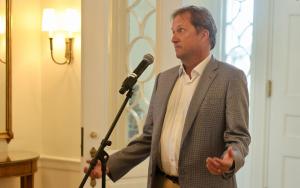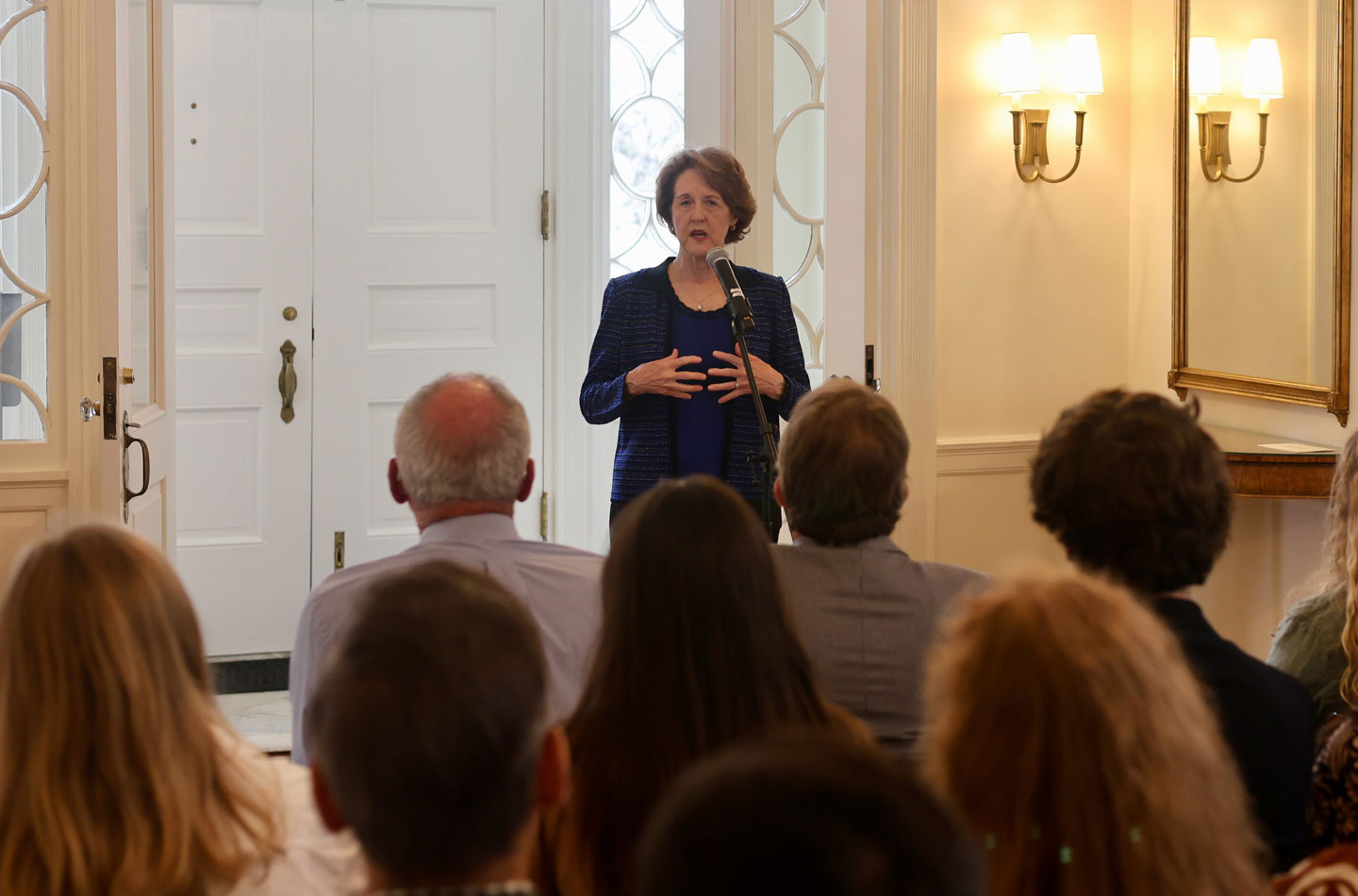
Upated Sept. 8, 2025 to add links to the Story Collider and Hoos in Stem podcasts.
Scott Acton, chair of the Department of Electrical and Computer Engineering at the University of Virginia, is well known for inventing ways to analyze medical images and video using artificial intelligence.
But he secretly desired to write and live like Ernest Hemingway, Acton drolly confided to an audience he kept in stitches at “Story Collider on the Hill,” held at Carr’s Hill, the home of UVA president James Ryan on Grounds.
Acton was one of four UVA faculty members who shared personal stories for two popular podcast series: “Story Collider” and “Hoos in STEM.” Hoos in STEM host and UVA math professor Ken Ono organized the special event for the third year.
Joining Acton from the School of Engineering and Applied Science was former NASA astronaut and emeritus professor of mechanical and aerospace engineering Kathryn Thornton. Stephanie Rowley, professor and dean of the School of Education and Human Development, and Bill Petri, a professor and vice chair for research in the Department of Medicine at the School of Medicine, also took turns at the mic.
Born to Write
Named after F. Scott Fitzgerald by book-loving parents, Acton’s dream of writing survived the criticism of the formidable Mrs. Winifred Campbell in eighth-grade English only to succumb to his Advanced Placement English teacher in high school. But by then, he’d discovered a talent for writing code and was earning royalty checks from “Space Raider,” a video game he programmed for the Commodore 64.
When the AP teacher informed him he was neither prepared nor skilled enough to succeed in her class, she was kind about it.
“She says, ‘Don’t take it too hard because I hear you’re really good at computers,” Acton said with perfect comedic timing.
Now he is a professor who makes “computers see with computer vision,” he said, and he’s never looked back — except once. With his career soaring and a happy family life with two sons at home, he pseudonymously submitted a novel to a contest. He won the “New Novelist” category.
“All of a sudden, I was Ernest Hemingway,” he said. “I’ve never shown the novel to another living soul. I think I know there’s a Winifred Campbell out there who’s ready to shoot it down. But she won’t get the chance because I have my novel and I’ve lived my fantasy life.”

Fixing a Giant Soup Can in Space
Thornton’s tale of capturing, repairing and redeploying a wayward telecommunications satellite on her second of four space shuttle missions for NASA likewise enthralled and amused listeners.
The crew had to improvise when the “capture bar” designed for the job repeatedly failed to grab the giant soup can-shaped “Intelsat” so it could be brought into Endeavor’s open cargo bay for repair. The shuttle is like a flying truck about a third longer and twice the width of a school bus, she said.
The plan? Send three spacewalkers instead of two to grab the satellite by hand. But all three had to fit into the airlock, a chamber designed for just two astronauts to transition between the pressurized vehicle and the vacuum of space.
“I was in charge of squashing ’em in there,” Thornton said. “So, I got one right side up, one upside down, and one L-shaped. It was like a can of sardines if sardines wore spacesuits.”
Simulations on the ground confirmed the plan should work, and it did. Intelsat, with a new booster motor to put it in proper orbit, was ready to deploy — except when Thornton flipped the last switch, nothing happened.
“Then we’re in a real pickle because a space shuttle with a satellite sticking out of its cargo bay cannot come home,” Thornton said.
The problem was quickly resolved, though, and a few months later Intelsat carried the Summer Olympics from Barcelona to American viewers.
Wooing a Funder and Becoming a Better Academic Writer
Petri recalled how 15 years ago, as the then-chief of UVA’s Division of Infectious Diseases and International Health, he landed funding from a prominent international philanthropic foundation for the division’s research.
He followed a hunch that connected his longtime work on enteric diseases to lowered effectiveness of polio vaccines that had been observed in low- and middle-income countries.
He found partners to add expertise on the polio side, because, Petri said, “[science] is the best team sport there is.”
Rowley conveyed a similar message with a funny but touching account of how her gifts in statistical analysis as a Ph.D. student masked underdeveloped paper-writing skills.
As a newly appointed tenure-track researcher, she overcame this painful reality by forming a support network of colleagues who helped each other using their respective strengths — and by putting in a lot of hard work to get those first papers published.
How to Listen
Hear about Acton’s journey from Hemingway wannabee to renowned expert in “computer vision” here or here.
Keep your ears pealed for more stories by subscribing to Hoos in STEM or visiting the website. Selected stories also appear on the Story Collider podcast.